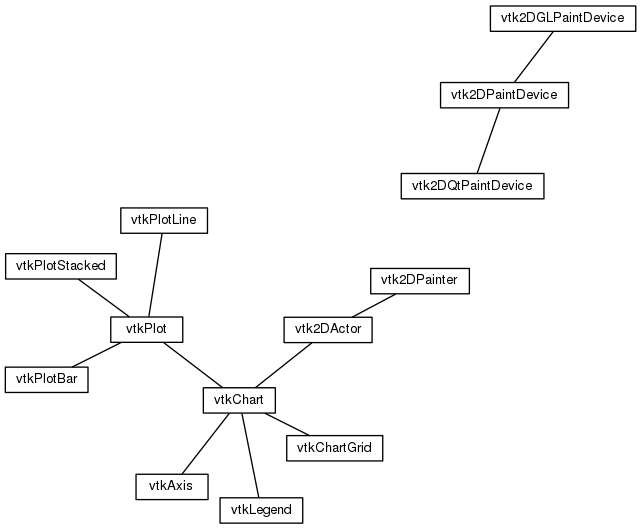|
|
| Line 1: |
Line 1: |
| == 2D API == | | == 2D API == |
|
| |
|
| The 2D API is currently made of of two levels, a concreate class called vtk2DPainter that is called by the paint functions of components operating within the 2D API, and a vtk2DPaintDevice which is called by the vtk2DPainter to actually draw to a context. The vtk2DPainter contains a pointer to the derived class of the vtk2DPaintDevice to do low level painting. This is the class that must be implemented for a new backend to be supported. The vtk2DPainter builds up more complex 2D constructs on top of the basic constructs implemented in the device.
| |
|
| |
|
| <graphviz renderer='neato' caption='2D API'>
| |
| digraph TWOD {
| |
| node [
| |
| fontsize = 10
| |
| fontname = Helvetica
| |
| shape = record
| |
| height = 0.1
| |
| ]
| |
|
| |
| edge [
| |
| fontsize = 10
| |
| fontname = Helvetica
| |
| ]
| |
|
| |
| // Classes
| |
| vtk2DPainter
| |
|
| |
| vtk2DPaintDevice
| |
| vtk2DGLPaintDevice
| |
| vtk2DQtPaintDevice
| |
| vtk2DCairoPaintDevice
| |
|
| |
| //
| |
| // Subclass relationships
| |
| //
| |
|
| |
| // A -> B means
| |
| // A is the superclass of B
| |
| // The notation is a bit counterintuitive but required to obtain
| |
| // the desired top-to-bottom layout
| |
| edge [
| |
| arrowtail = onormal
| |
| arrowhead = none
| |
| ]
| |
|
| |
| vtk2DPaintDevice -> vtk2DGLPaintDevice
| |
| vtk2DPaintDevice -> vtk2DQtPaintDevice
| |
| vtk2DPaintDevice -> vtk2DCairoPaintDevice
| |
|
| |
| //
| |
| // "owns the lifetime of"
| |
| //
| |
|
| |
| edge [
| |
| arrowtail = diamond
| |
| arrowhead = none
| |
| ]
| |
|
| |
| //
| |
| // "has a pointer to"
| |
| //
| |
|
| |
| edge [
| |
| arrowtail = odiamond
| |
| arrowhead = none
| |
| ]
| |
|
| |
| vtk2DPainter -> vtk2DPaintDevice
| |
| }
| |
| </graphviz>
| |
|
| |
| The class relationship diagram is shown above. The headers for the two classes look as follows.
| |
|
| |
| <source lang="cpp">
| |
| class VTK_CHARTS_EXPORT vtk2DPainter : public vtkObject
| |
| {
| |
| public:
| |
| vtkTypeRevisionMacro(vtk2DPainter, vtkObject);
| |
| virtual void PrintSelf(ostream &os, vtkIndent indent);
| |
| static vtk2DPainter *New();
| |
|
| |
| bool Begin(vtk2DPaintDevice *device);
| |
| bool End();
| |
|
| |
| // Line drawing functions
| |
| void DrawLine(float x1, float y1, float x2, float y2);
| |
| void DrawLine(vtkPoints2D *points);
| |
| void DrawPoly(float *x, float *y, int n);
| |
| void DrawPoly(vtkPoints2D *points);
| |
| void DrawRectangle(float x, float y, float width, float height);
| |
| void DrawRectangle(float *p);
| |
| void DrawRectangle(vtkPoints2D *points);
| |
|
| |
| // Point drawing functions
| |
| void DrawPoint(float x, float y);
| |
| void DrawPoints(float *x, float *y, int n);
| |
| void DrawPoints(vtkPoints2D *points);
| |
|
| |
| // Manage the state of the painter
| |
| void SetColor(int r, int g, int b, int a);
| |
| void SetPointSize(float size);
| |
| void SetLineWidth(float width);
| |
|
| |
| protected:
| |
| vtk2DPainter();
| |
| ~vtk2DPainter();
| |
| };
| |
| </source>
| |
|
| |
| While the vtk2DPaintDevice header for the equivalent primitives is,
| |
|
| |
| <source lang="cpp">
| |
| class VTK_CHARTS_EXPORT vtk2DPaintDevice : public vtkObject
| |
| {
| |
| public:
| |
| vtkTypeRevisionMacro(vtk2DPaintDevice, vtkObject);
| |
| virtual void PrintSelf(ostream &os, vtkIndent indent);
| |
| static vtk2DPaintDevice *New();
| |
|
| |
| // Set up the paint device context
| |
| virtual void Begin(vtkRenderer* renderer) { }
| |
|
| |
| // Clean anything up once rendering has been completed
| |
| virtual void End() { }
| |
|
| |
| // Line drawing functions
| |
| virtual void DrawPoly(vtkPoints2D *points) = 0;
| |
|
| |
| // Point drawing functions
| |
| virtual void DrawPoints(vtkPoints2D *points) = 0;
| |
|
| |
| // Manage the state of the painter
| |
| void SetColor(int r, int g, int b, int a);
| |
| void SetPointSize(float size);
| |
| void SetLineWidth(float width);
| |
|
| |
| protected:
| |
| vtk2DPaintDevice();
| |
| ~vtk2DPaintDevice();
| |
| };
| |
| </source>
| |
|
| |
|
| <graphviz renderer='neato' caption='Chart Classes'> | | <graphviz renderer='neato' caption='Chart Classes'> |
